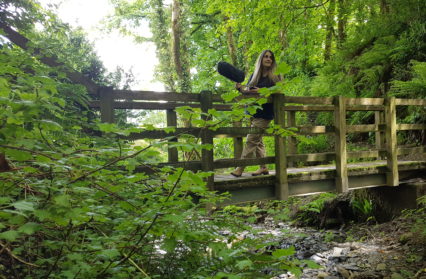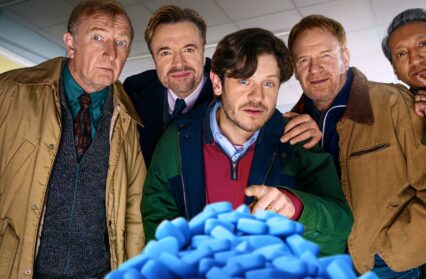Hearing impaired, environmental sound artist Cheryl Beer has spent the last year working with the ancient rainforests of Wales, where she has composed music led by the vascular systems of four remaining enclaves. Using hearing aid and sensitive biomedical sound equipment, Cheryl has collated biorhythms created by conductivity deep within trees, ferns and moss, using these readings to compose her new project, CÂN Y COED Rainforest Symphony. Ally-Joh Gowan-Day caught up with Cheryl Beer to hear more about the CÂN Y COED Rainforest Symphony, a symphony led entirely by the conductive biorhythms of trees.
Ally-Joh Gowan-Day: Could you talk a little bit about your project ‘Song of the Trees? How did the idea come about?
Cheryl Beer: ‘Where are the birds this morning?’ I thought to myself – ‘why is there no birdsong?’ – instead, my head was filled by a cacophony of ringing and hissing noises. As a musician all my life, sudden hearing loss, tinnitus and a sound sensitivity called hyperacusis which distorts sound, made my career untenable; music had been my passion, my sense of identity – it was a dark time, but I was living opposite a little woods in Carmarthenshire and I realised that the longer I bathed in her rivers, laid on her moss, pressed my back against her trees, the less attention I gave to the destructive nature of my hearing impairments.
It was 9 months before I received my hearing aids from the NHS – and in that time, nature became my constant nurture. Once I had my hearing aids, I started to get a little more confident and began recording nature narratives, particularly for older people with dementia – because one of the side effects of dementia, can be a sound sensitivity very similar to mine and I realised that with my music studio and my visceral understanding of how nature heals, I could set up my sound systems to record and edit soundscapes that helped others.
Ally-Joh Gowan-Day: When did you realise that you wanted to work closely with nature? Have you always felt connected to the natural world, and do you think it’s something we might have lost touch within the digital era?
Cheryl Beer: I suppose I have always felt connected to nature, but not as deeply as this since being a child. My mother used to say, ‘Other children have toys under their bed, not sticks, acorns and leaves!’ – in this time of crisis, perhaps I naturally returned to the deepest essence of Self.
Then the pandemic came and I created a project called WALK19 funded by ACW (Arts Council of Wales), working online with activities coordinators in nursing homes, where older people were locked down and locked in. I collated their favourite walks and created nature narratives based on these. This became very popular with over 8000 people attending the online sound exhibitions – you can see the work at Sound Memories Dementia Friendly Radio Station.
It was during this time that it occurred to me how amazing my hearing aids were – they had given me back a sense of creativity – but I wondered, could they be the art itself? What technology fuelled them and was there a way I could repurpose that to listen more intensely to nature? So, rather than seeing technology as something that takes us away from it, how could it be repurposed to bring us closer to the natural world?
Still in the pandemic, I applied for a research mentorship with Addo Creative Consultancy and successfully secured 4 months funding to explore the repurposing of hearing aid technology. At first, I thought it would be through visual sound and I made some glass pieces of the spectral sound of the sea.
However, something happened whilst I was doing my research. FUSION Carmarthenshire, funded training for me in spectral frequency – the technology used in hearing aid tests along with digital sound, to ascertain which pitches of your hearing need to be enhanced. I had an ‘aha’ moment, where I realised that actually, I wasn’t just measuring the visualisation of sound, I was measuring the pitch. So, I began notating this onto musical staves. Of course, once I had done this for sea biorhythms, I started working with other elements, notating the wind, for instance, and then I thought … What if I could repurpose other biomedical technology to hear beneath the bark of trees? And this became my line of enquiry.
Ally-Joh Gowan-Day: Your work reunites ancient Celtic grounds, could you explain a little more about what that entails and why it’s important?
Cheryl Beer: Because of what had happened to me and how nature continued to heal and bring me back to myself, it felt really important to base my new found practice in areas of natural distress. As a conduit composer, I empower nature with her own voice and in turn, am paying her back. So, I decided to investigate ways of working with the fragile ecology of rainforests.
When I did a search, I expected to be packing my bags for the Amazon, but to my utter surprise, I found that we have pockets of Celtic rainforest, right here in Wales and people barely know about them. They are cared for by the Celtic Rainforest Project which is a consortium of the Coed Cadw /The Woodland Trust, Snowdonia National Trust, RSPB, and the Wildlife Society.
Having found this out, I applied for an Unlimited Main Commission to bring back together these Celtic enclaves that were once one mighty rainforest before we built nuclear power plants, roads, dams and towns. I organised residencies with the Celtic Rainforest Project and engaged with other organisations that might be interested in the work or offer scientific support, like the National Botanic Garden of Wales, so that by the time I was selected, I had built a network of incredible people that supported my Commission.
Ally-Joh Gowan-Day: What do you hope people will take from your Rainforest Symphony? And how was it launching at the National Botanic Garden of Wales?
Cheryl Beer: The launch at the NBGW was absolutely beautiful. Surrounded by all the people that have supported me to compose the piece, from my hearing assistant to the funders. I also unveiled a permanent sign that sits with an oak tree in an accessible spot, so that when you visit, you can transport yourself beneath the bark and listen to the Song of the Trees, sitting with your back pressed against a trunk, just as mine was when I first lost my hearing.
Bruce Langridge, Interpretations Manager at NBGW said that my work puts a heartbeat into the ecology of trees. Kirsten Manley of Coed Cadw said that I am ‘the voice of the trees’. Curator of the Garden, Alex Summers, said that I have changed how he views working with the senses and that my work has been significantly important in raising awareness of the rainforests.
My hope is that Cân y Coed Rainforest Symphony connects people emotionally to the incredible eco systems on their doorstep. Our rainforests have moss carbon dating back 10,000 years and I have collated the biorhythms of that moss to compose music led by it. Coed Felinrhyd rainforest is named in the Mabinogion, so it is culturally, as well as ecologically, significant to Wales.
Ally-Joh Gowan-Day: What comes after the Rainforest Symphony? Is there anything else in the pipeline?
Cheryl Beer: Concurrently, The Senedd launched the audio-visual of Cân y Coed Rainforest Symphony on a film roll in their immense reception hall and it is being exhibited for 2 weeks. My launch presentation from NBGW is sited with Disability Arts Cymru who launched it on the same day, making me their Artist of the Month. In addition, on launch day AMAM creative app launched the presentation. The following day, Cân y Coed Rainforest Symphony joined Hijinx Unity Festival at Chapter Film Festival and then 4 days at the Millennium Centre and is currently touring Wales with them.
I am preparing to visit The Orkney Islands for a live performance art piece with WAIWAV (We Are Invisible We Are Visible), a national disability ats intervention led by DASH where 30 artists have been selected to perform at galleries across the whole of the UK, and my work is included in a limited-edition book that accompanies the intervention that will be referenced at prestigious galleries, including the Tate and Tate Modern.
Cân y Coed Rainforest Symphony is at the Eisteddfod with a special edition to accompany Marc Rees’s CORAN CARON in September. It will also appear with Wales Arts International at the ‘Decade of Indigenous Languages’ in the Welsh Govt. tent.
Cân y Coed Rainforest Symphony audio visual is then going to the Southbank Centre in London for the 4 days as part of the Unlimited festival. Following this, it is appearing with Head for Arts for Green Week. In addition, Coed Cadw exhibited Cân y Coed Rainforest Symphony at the Celtic Rainforest Festival and there is a permanent sign now at Elan Valley Information Centre so that rainforest visitors can be with the trees who collaborated. Smaller wooden QR codes are being sited at the entrance of the rainforest, acting as a portal to the Symphony in the rainforests themselves.
And this is just the beginning, there are already lots of very exciting adventures being planned for 2023 – my Unlimited Commission has become a career and in fact more than this, it is a vocation, a calling, if you like, where, after quite a journey, I can say: My name is Cheryl Beer. I am an Environmental Sound Artist and Composer, repurposing hearing aid and other sensitive biomedical technology, to work with the vascular systems of trees, thus composing music led by nature in distress. I am privileged to be a conduit for the natural world, raising awareness with a uniquely quiet and yet deep activism.












